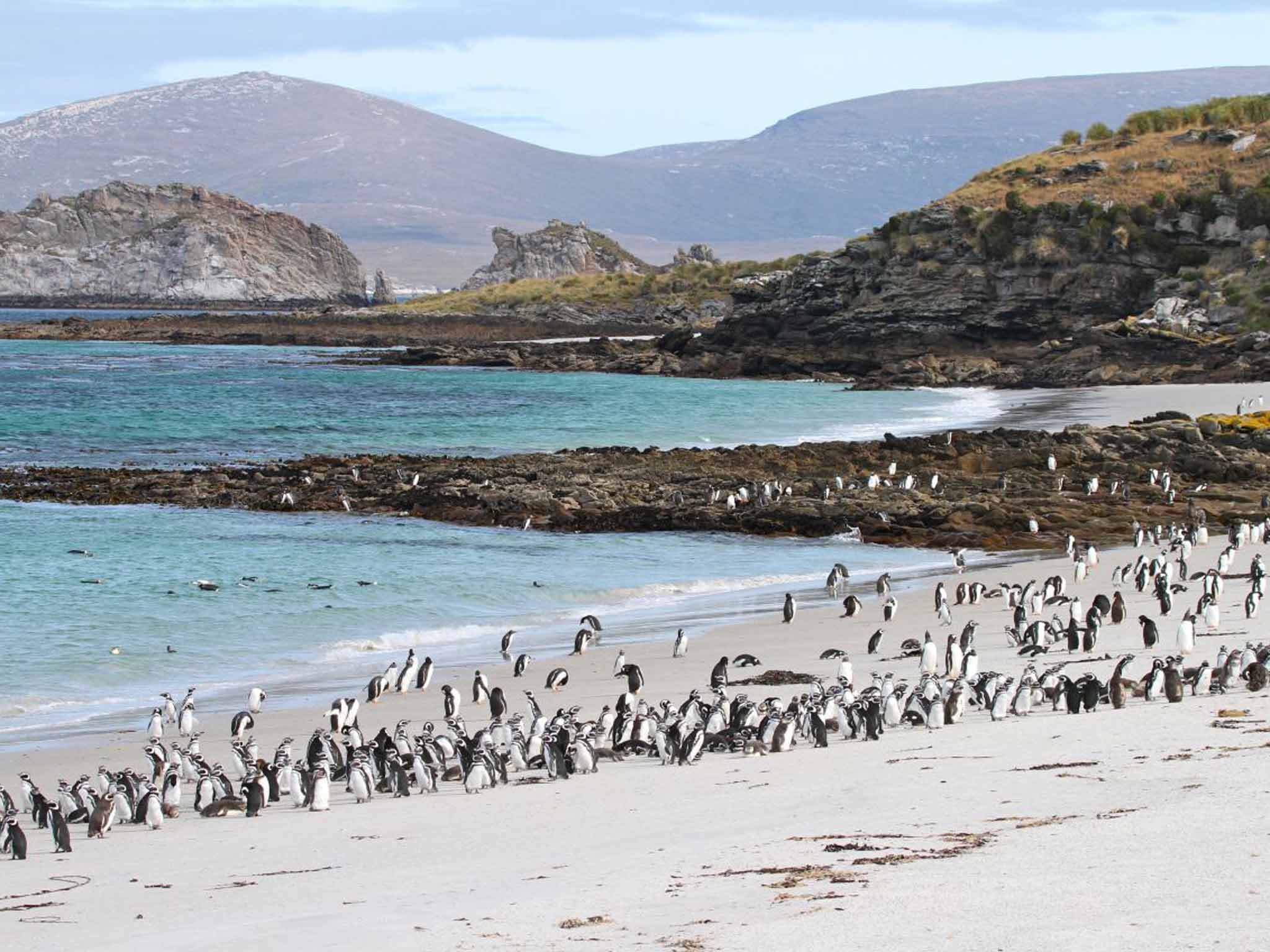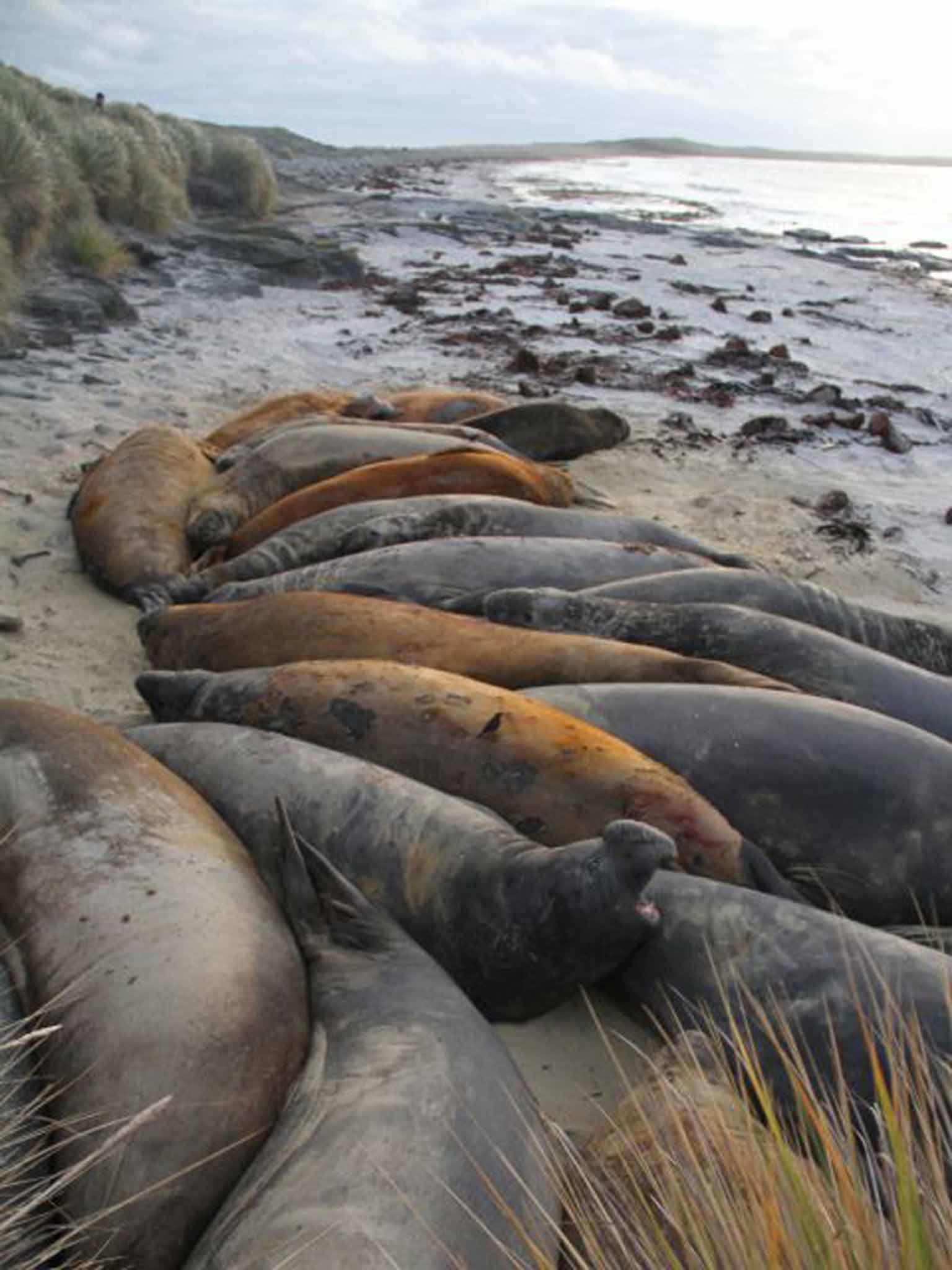Falkland Islands: A landscape that's strictly for the birds
From its thriving albatross population to rockhopper, gentoo and king penguins, Mike Unwin gets within sniffing distance of this avian archipelago's wildlife

A two-metre span of low-flying albatross swoops overhead, sending me ducking back down into the springy, unforgiving tussac grass. I grope for a footing then re-emerge, trying to orientate myself. Another careers by, webbed feet lowered for landing. It seems I'm bang in the flight path, with the great birds touching down at their nests just below me.
A clearing allows a more relaxed view of the action. All around me albatross nestlings squat on their mud pedestals, like fluffy white dodos on plinths. Their parents sweep in on rotation, each angling to brake before landing by its chick. A clatter of bills follows before the adult launches back out over the churning breakers 30 metres below, leaving the youngster with a gullet-full of squid and a slightly foolish expression.
The Falkland Islands are home to nearly 70 per cent of the world's breeding black-browed albatrosses. Here, on West Point Island, they are not the only avian attraction. Rockhopper penguins move through the surf. Southern giant petrels – like dirtier, more menacing albatrosses – cruise the headlands. And turkey vultures scavenge any casualties.
The visual drama is matched by the noise – squawking, braying, bill-clattering – and overpowering aroma: a pungent potpourri of dead bird, guano, and regurgitated fish that permeates every thread and pore.
West Point is one of the 780 or so islands that make up the archipelago. The birds share this island with just two people. Mike and Jeanette Clarke live here in summer only, tending the sheep. Jeanette serves up home-baked banana bread and a revitalising cuppa to the sounds of the Falkland Islands Radio Service playing Johnny Cash and Elvis. "Seems there are even more albatrosses this year," Mike tells me, in the local West Country-meets-Antipodes accent. This is good news, given how albatross numbers elsewhere have been plummeting.
West Point Island is a one-hour boat trip from Carcass Island, in the far northwest of the Falklands. I had arrived on Carcass two days earlier. I took a 20-minute flight from East Falkland, one of the two large islands that constitute the "Mainland". As the eight-seater descended over a Hebridean landscape of sheep-cropped sward and white-sand beaches, we watched a beetling Land Rover tow the fire-trailer into position beside the cricket-strip runway. This was hardly Gatwick.

On the ground, Rob McGill, owner of the Land Rover – indeed, of the whole island – welcomed us with a ruddy grin to the cosy guesthouse that he runs with his wife, Lorraine. Their only neighbours were birds. Upland geese, steamer ducks and other waterfowl loafed on the foreshore with farmyard tameness, while striated caracaras – scavenging raptors known locally as "Johnny Rooks" – alighted on lawn and fence post on the lookout for scraps.
While the McGills' guests enjoy snug seclusion, life is rather noisier and more public for the island's dominant inhabitants: its penguins. At Leopard Beach, on Carcass's southern tip, we slumped down on a grassy headland to watch the action. Thousands of the birds were bobbing out of the breakers, waddling across the sand and trooping over the dunes. The two species on view seemed as distinct in temperament as they were in markings. The magellanic penguins – smaller, with a stripier livery – huddled into close-knit groups and appeared panicky at our approach. The gentoo penguins, with bright orange bill and white tuft over the eye, moved more confidently, commuting inland in a relentless procession.
Even the most empirical of scientists must surely come over all Happy Feet around penguins. As though the waiter outfit and endearing waddle weren't enough, the birds' actions are endlessly compelling. I found myself watching a single gentoo walk in the opposite direction to a long file of its companions. Each of them paused in turn to watch, as though troubled by the action of this maverick individual. As each paused, the one immediately behind had to check itself to avoid a collision, briefly threatening a domino-style comedy collapse of the whole column.
As with the albatrosses, it was thrilling to watch from such close quarters. And not only the penguins. Antarctic skuas – predatory relatives of gulls – tended fluff-ball chicks just metres away, while caracaras eyed up our sandwiches. A Cobb's wren – a diminutive songbird endemic to the Falklands – fossicked around a rock pile at my feet.
But while birdwatchers may think of albatrosses and penguins, the Falklands carry different associations for many visitors. "That's my favourite bird," our host Graham Didlick had joked on Day One, pointing at a framed photograph of a Tornado jet on the wall of his guesthouse in Darwin, East Falkland.
Falklanders do not need the controversial antics of the Top Gear team to be reminded of the 1982 hostilities. Locals know it as "the conflict". It claimed more than 900 lives and put these remote islands on the world map. Grumbles from Buenos Aires were answered by a chest-thumping 99.8 per cent "yes" vote in a 2013 referendum among islanders over whether or not to remain British. On the ground, the military presence is inescapable – as are the posters in every guesthouse and Land Rover window reading "Falkland Islands: British to the core".
For the outsider, not wedded to the land, it is hard to imagine that this remote and largely uninhabited archipelago could possibly have been worth the bloodshed. The territory is more than half the size of Wales, with fewer than 3,000 people. Its qualities seem fundamentally more suited to penguins than people.
Violent conflict was definitely the order of the day, however, when I strolled down to the beach on Sealion Island – our next port of call. Two bull southern elephant seals were slugging it out in the breakers. Blubber rippled along their immense bodies as they galumphed through the drifting kelp and up on to the sand, arching their forequarters skyward to trade massive blows with ripping teeth. The larger of the two – a good three tonnes in weight – was getting the upper hand; blood flowed freely from his opponent, whose wobbling proboscis flared with the exertion.
I watched from just 10 metres away, backing off whenever the combatants lumbered too close for comfort. Behind me were the huge, slug-like bodies of more recumbent elephant seals. Oblivious to the violence, which breaks out every time a young pretender challenges the "beachmaster", they emitted a sporadic, flatulent chorus of belches, snores and sighs, occasionally scooping up a spray of sand with one irritable flipper.
Sealion Island lies to the far south of the Falklands, an hour's flight from Carcass, and has been a national nature reserve since 2009. Its wildlife, again, is astonishingly accessible. From the windows of my lodge, I could watch gentoos massing beyond the perimeter fence and spy the spouts of passing sei whales in the sound. Excursions require no vehicle or guide. I simply packed my sandwiches and stepped out along the island's trails, peering down from cliff paths on to jostling colonies of southern sea lions; ducking the furious bombardment of nesting terns on the shingle ridges; and wandering the beaches, where gentoos parted before us like the Red Sea.
There was no rush to tick off a list of species. Indeed, species here are relatively few. It was all about quality over quantity: simply plonking yourself down to watch, allowing the animals to come to you and becoming steadily immersed in their world.
On one lonely headland a discreet memorial honours the 20 men of HMS Sheffield who died on 4 May 1982 when their ship was struck by an Argentinian Exocet missile. I saw no other sign of humanity, but birds were everywhere: cormorants crowding the sea stacks, giant petrels sweeping past, and rockhopper penguins doing what their name suggests, saffron head gear quivering and flippers outstretched as they negotiated the boulder field.
My week ended in Stanley. The Falklands' capital is so small that its population more than doubles every time a cruise ships docks. Nonetheless, the cluster of a gift store, coffee shop and Tarmac car park, and the trimmed lawns of Thatcher Close, came as a surprise after a week in the wilds.
There was time, though, for one final rendezvous with the penguins. And not just any kind; king penguins. The largest of the archipelago's five species is easily recognisable to anybody who's ever unwrapped a chocolate biscuit. A two-and-a-half hour drive took me over boggy, hummocky terrain north-east to Volunteer Point, where an impressive breeding colony of these handsome birds, their black-and-white emblazoned with yellow and orange, clustered behind the dunes and trooped back and forth past indifferent sheep.
Other tourists duly arrived – this is the Falklands' most accessible penguin colony – but the human invasion didn't faze the birds. Kings and gentoos alike went about their business while I scoffed my sandwiches and exhausted my memory card. Sunlight glinted on albatrosses cruising beyond the breakers. It seemed a place of unfettered nature; a place where territorial rights – whoever claimed them – didn't belong to our species at all.
Getting there
LAN (0800 977 6100; lan.com) flies from Madrid via Santiago and Punta Arenas to Mount Pleasant, East Falkland. With connecting flights from Heathrow, the fare is around £1,400.
A faster option is the twice-weekly Ministry of Defence flight (with civilian charter) from RAF Brize Norton in Oxfordshire via Ascension Island for £2,222 return. Flights leave the UK on Sundays and Wednesdays. Bookings are made through the Falkland Islands Government London Office (0207 222 2542; travel@falklands.gov.fk).
Getting around
Audley Travel (01993 838 000; audleytravel.com) can tailor Falklands itineraries. A nine-night tour coasts around £3,500pp, with one night at Darwin House on East Falkland, two nights on Carcass Island, two nights on Sealion Island, two nights in Stanley, and two nights in Santiago, Chile. The price includes some excursions plus transfers at the beginning and end, but not flights.
More information
Join our commenting forum
Join thought-provoking conversations, follow other Independent readers and see their replies
0Comments